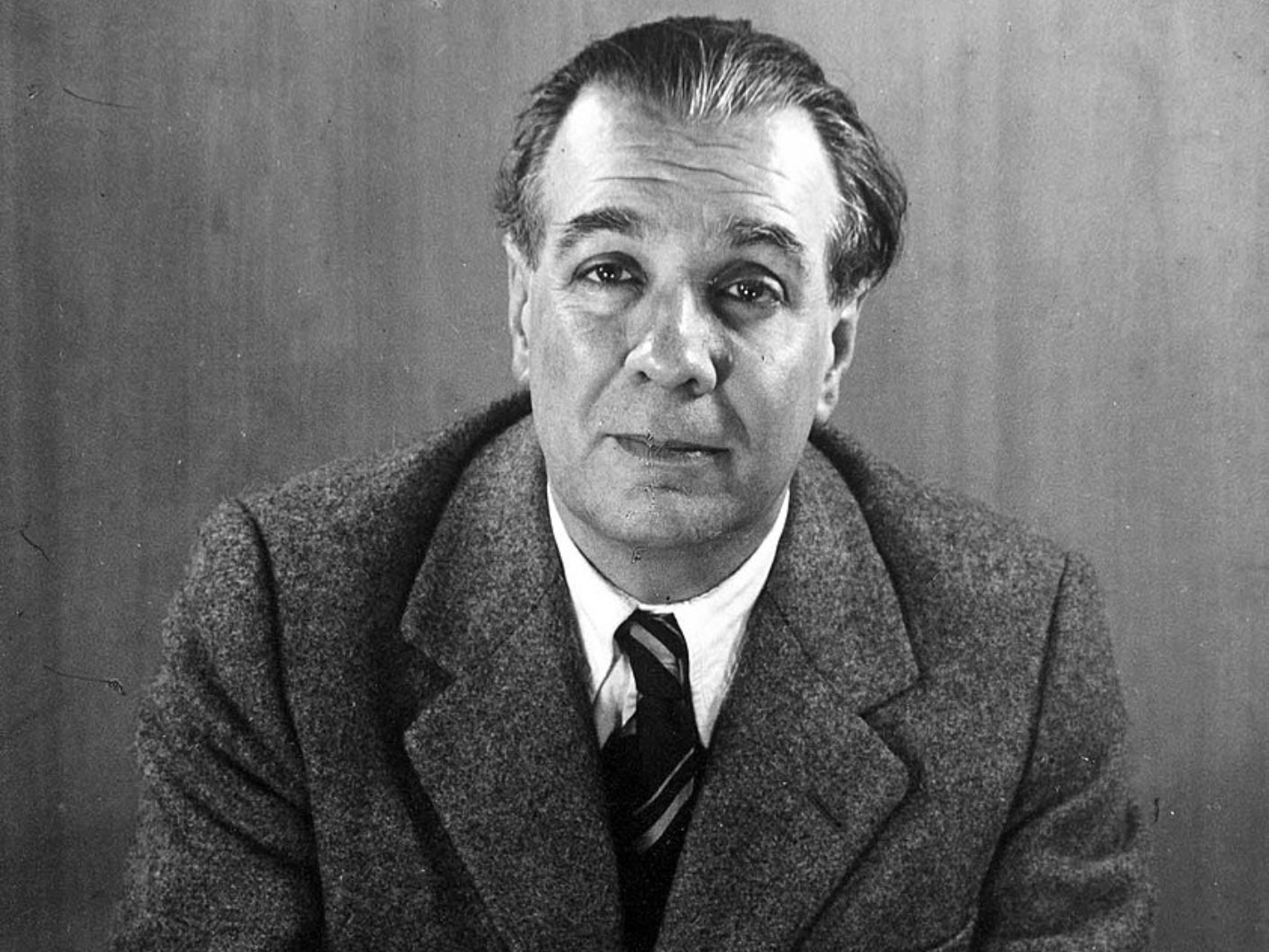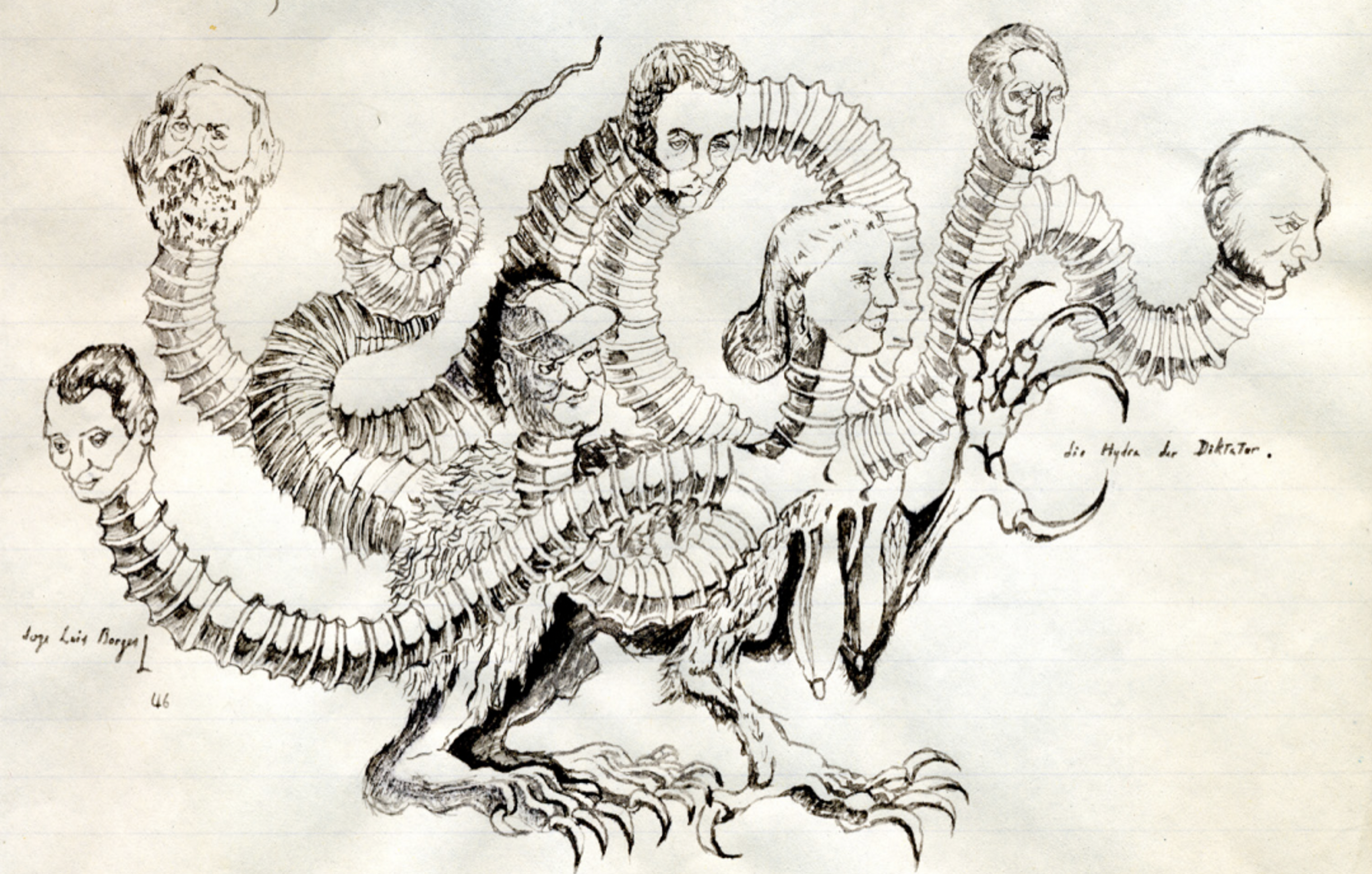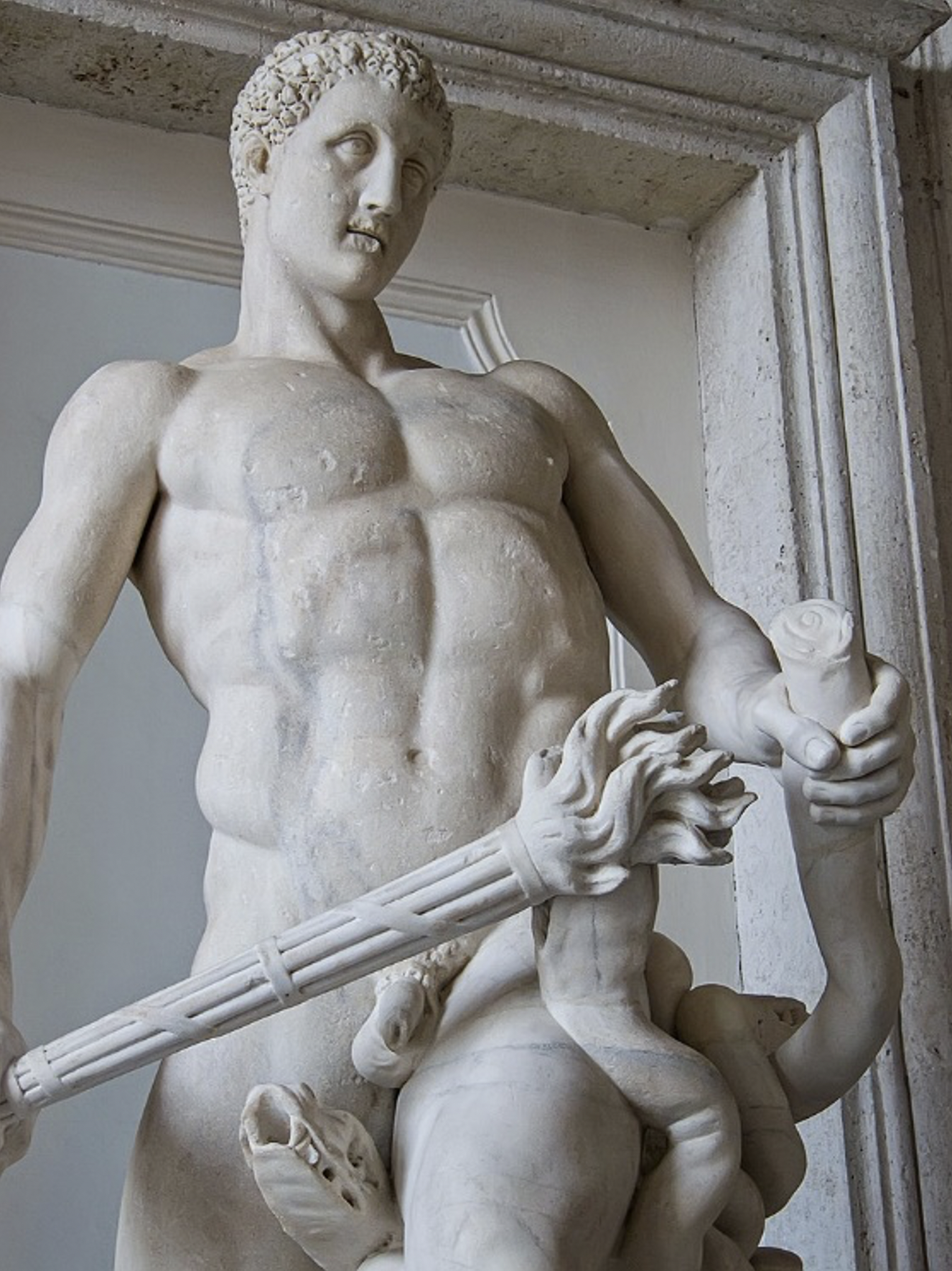
“Die Hydra der Diktator” (1946) is a famous drawing by Jorge Luis Borges (1899–1986) finished about a decade before he went blind in 1955. Today Borges rests firmly in the pantheon of classical liberalism. His stories convey a complex, yet also mysteriously ordered vision of the cosmos. His smooth, organic style makes him particularly compatible with a number of twentieth-century philosophers from the Austrian School—Mises, Hayek, and Rothbard, to name three. He provides elegant fictional articulations of: (1) Mises’s rejection of syndicalist certainty, (2) Hayek’s understanding of spontaneous order, and (3) Rothbard’s nightmare of the state as the primary threat to personal liberty. Javier Cercas, a leading figure among Spain’s current generation of novelists, observed recently that Borges was not as liberal as many would have it. Fair enough. Let’s look at his mood at the end of WWII.

Jorge Luis Borges, “Die Hydra der Diktator” (1946)
“The Dictator’s Hydra” appears in the manuscript of an essay titled “Our Poor Individualism” (1946), which is also of great interest. The essay can be found in the Jorge Luis Borges Collection of the Alderman Library at the University of Virginia. It’s an Argentine take on the political landscape at the end of WWII. Left to right, we have Miguel Primo de Rivera, Karl Marx, Juan Perón, Juan Manuel de Rosas, Eva Perón, Adolf Hitler, and Benito Mussolini. Our immediate impression is correct. These military, political, and ideological tyrants form a menacing monster which overwhelms the Argentine individualism sketched out in the essay.
The German title of the drawing underscores its double origins by way of Marx and Hitler, i.e., the communist and fascist poles of nineteenth- and twentieth-century populism. Hamilton does something similar in Federalist 29, in which the hydra alludes to the political and religious schism of the prior century’s English Civil War. In Borges’s hydra, the polarity between communism and fascism is akin to Hamilton’s polarity between Protestantism (Parliament) and Catholicism (Monarchy). Signaling this background, Borges forms an originary binary at the upper corners of his hydra in the heads of Marx and Hitler. Hamilton’s binary comes into view through his citation of Milton’s Paradise Lost(1667): “Gorgons, hydras, and chimeras dire.” This contextualizes the American War of Independence as the latest example of a tendency to split into rival groups, one which dates at least as far back as the Reformation.
One can imagine each of these scenarios provoking a desire to locate political enemies. Following Hamilton in Federalist 29, the schism of the Reformation allows a reference point for a new political hydra to take shape in the United States. Following Borges’s drawing in “Our Poor Individualism,” another epic Anglo-Germanic schism—this time between fascists and communists—is a more recent reference point by which to think about a political hydra of dictatorships stalking Italy, Spain, and Argentina.
In Federalist 29, those debating the Constitution of 1787 have a problem before them that has not yet led to armed conflict: slavery. What brings them together is that everyone in the room is a newly fallen rebel. There’s no way to rejoin the English sociopolitical order. All have thrown in with Milton’s Satan, as it were; all contemplate the same monsters in a Hell of their own making. Nevertheless, by means of his second hydra in Federalist 80, Hamilton specifies that there already looms a battle over slavery, with the power of the Southern legislatures in its defense. He hints at a civil war greater than the English one in his allusion to Milton in Federalist 29.
For his part, after orienting us by way of Marx and Hitler, Borges places five heads of Latin dictators in the foreground of his hydra: Mussolini, Primo de Rivera, Rosas, and Juan and Eva Perón. Borges’s single hydra represents two ideological reference points plus a set of populist tyrants; Hamilton’s two hydras represent the enemies in the English Civil War plus the oppressive state legislatures.
Setting aside the German tyrants, the struggle for the survival of Latin individualism against a hydra of dictators is, for Borges, a more Mediterranean and Latin American drama: one-fifth Italian (Mussolini), one-fifth Spanish (Primo de Rivera), and three-fifths Argentine (Rosas, Juan and Eva Perón).
We should not be surprised that both Borges and Hamilton signal where to cut, that is, they indicate the tyrants to be sacrificed. Citing Milton, Hamilton establishes a Renaissance origin for his political hydra. He also acknowledges that while his new nation was being forged, there came an almost miraculous pause in warfare and ideological strife. Nevertheless, another serious conflict already looms between the federal government and the state legislatures. The latter are the new hydra with which Hamilton is now preparing to do battle.
[More from Eric Clifford Graf: “Alexander Hamilton’s Hydras in Federalist 29 & 80”]
In the more international and modern political hydra produced by Borges, by contrast, we might imagine conflict, populism, and tyranny to be more recent, ongoing, and tangible. Perhaps the pressure, memory, and scale of the carnage worldwide in the 1930s and 40s explains why Borges turns so deeply philosophical toward the end of his essay, even fantasizing about a mythical rebellion against government goons led by romantic Argentines:
The most urgent problem of our times … is the gradual incursion of the State into the activities of the individual; in the struggle against that evil, which is called both communism and Nazism, Argentine individualism, perhaps useless and prejudicial until now, will find duties and justification. Without hope and gripped by nostalgia, I imagine the abstract possibility of a party that could have some affinity with the Argentine people, a party which might hold forth the promise of, say, serious limitations on government.
Borges offers additional reference points for understanding his hydra. The author was bilingual, for example. His hydra perforce alludes to the Anglo tradition of Milton and Hamilton but also to the Hispanic tradition of Cervantes. Signaling continuity among English, American, Latin American, Spanish, Italian, and Greek cultures, Borges leans more heavily than Milton and Hamilton in the direction of archaic Mediterranean myth. Hercules, the ultimate victor over the hydra, is the mythological character most associated with Spain. Jebel Musa and Gibraltar are the “Pillars of Hercules” seen in Habsburg iconography. As we might expect, don Quijote has much in common with Hercules. He seizes a primitive mace in DQ 1.8; he cleans a Spanish version of the Augean stables in DQ 2.25.

Hercules Slaying the Hydra (Capitoline Museum, Wikimedia)
Roman copy of fourth-century BCE statue by Lysippos
Borges himself opens the door for an imaginary encounter between his hydra of dictators and Cervantes’s don Quijote in the guise of Hercules. He does this when he reflects on a very specific rebellious spirit still shared between a Spaniard and an Argentine.
He feels along with D. Quijote that “each should answer yonder for his sins” and that “it’s not right for honorable men to be the executioners of others when it’s nothing to them” (DQ 1.22). More than once, when confronted by the otiose symmetries of the Spanish mode, I’ve suspected we differ irredeemably from Spain; these two lines from the Quijote have been enough to convince me of my error; they are like the secret and tranquil emblem of our affinity.
Here Borges not only signals a secret alliance between rebellious Spaniards and Argentines against a hydra of tyrants; in the process he confronts no less of an English conservative than Edmund Burke. In Reflections on the Revolution in France (1790), Burke denounced the folly of liberating the galley slaves in DQ 1.22. He argued that respect for the rule of law mattered more than the freedom of the prisoners. In 1946, Borges declares the law perverse and endorses the hero’s original plan. The expressly quixotic gesture by Borges in “Our Poor Individualism”—for rebellion and against authority—recalls Hamilton’s postcolonial pronouncement early in The Federalist Papers: “Facts have too long supported these arrogant pretensions of the Europeans. It belongs to us to vindicate the honor of the human race, and to teach that assuming brother moderation” (F11).
Given Borges’s drawing of a monster slain by the mythological hero most associated with Spain, and given his explicit quotations from DQ 1.22 in the accompanying essay, why do we not find Franco among the heads of this hydra? Is this the writer’s way of insisting—as he does in the essay—that Argentines stop blaming their political misfortunes on Spanish colonialism? Or is this a game of perspectives, whereby Borges forces his viewer to be more precisely like Hercules before the Hydra, and thus implicitly seeking out Franco’s head regardless of which one he chooses to sever first. This seems a very Borgesian irony. Hercules searching for Franco’s head has a circular element of existential madness to it. Then there’s the possibility that Franco’s head has already been removed in a gesture of authorial rebellion. This assumes Borges identifies with Hercules, which seems likely. On the other hand, what if a dictator were indeed necessary in order to avoid worse dictators? Perhaps we can only judge Franco according to the ideas and actions of other dictators who tried to navigate similar political environs.
In any case, I think Borges signals yet another way of thinking about the generation of Latin American writers known as the Boom. What if magical realism were an ingenious attempt to temper the conflicting tides and traumas of twentieth-century populism? Like the continental philosophers of post-war Europe, if great Latin American novelists sought to disorient their readers, was that not also to avoid further bloodshed? This is perhaps a generous view of both movements. But were they not successful, perhaps even in spite of themselves? Maybe philosophy and fiction have other ways of outmaneuvering violence. Surreal, yet recognizable (pseudo-constitutional) narratives might shepherd civil society through suffering. Could not Latin America have been much worse off circa 1946? It was not in ruins like Europe, so maybe the novel worked. Then again, neither was Latin America about to be rebuilt from scratch, so the novel might still be needed if similar tensions return in the future.
Hercules kills the Hydra “South of Corinth.” That would be a good marketing phrase for a Hollywood film about the Peloponnesian War. Trade over the Isthmus of Corinth was the origin of the massive wealth that coincided with the rise of Greek civilization. The idea was advanced by both Thucydides (5th century BC) and Apuleius (c.175 AD), inventors of history and the novel, respectively. It’s easy to imagine a journey south of a place like Corinth as an encounter with barbarism ending with a victory over a monster. For Greek civilization to exist, a Greek hero had to pacify its environment. Like most myths, this one likely cloaks intrahuman violence by way of a hero’s victory over a monster.
Around 1789, and again around 1945, imagining new national adventures seemed to pose new risks. These were murky moments of great global crisis. Change seemed more consequential and difficult to control than before. In The Federalist Papers, James Madison ponders a surreal kind of “unsacrificed residue” (F45), whereas Hamilton methodically plans to hunt down what he sees as the new hydra of the state legislatures (F29, F80). Meditating on a post-WWII and post-nuclear social order, Borges draws on the same mythological monster. As in the work of Milton and Hamilton, there’s something surreal, and also precise, about Borges’s metaphor for a common political phenomenon that seems to be returning.
[More from Eric Clifford Graf: “Liberty and the Subterranean in the Fantasy of Lewis Carroll”]
There are at least two other indications that Borges’s “Our Poor Individualism” is the record of a special kind of transatlantic “constitutional crisis.”
(1) The original text was anxious to say the least, indicating a desire for precision against an elusive enemy in a difficult situation. Borges was notably precise, as much a poet as a writer of essays and stories, but this appears to have been extreme even for him. Here are the first few lines of the manuscript; the rest is similarly expansive, bracketed, disjointed, and, one might even say, hydra-like in the way it has been dissected into so many pairs of options:
{The [allures + factions] + The spirits} {[animated + driven mad] [from + (of + by the)] [(patriotism + pride) + fatuousness]} {know no limits + are [infinite + inexhaustible]}. In the first century of our era, Plutarch {was mocking + mocked} {before those declaring + about those who declare} themselves partisan to the idea that the moon {she being Athenian + [— + (enamored)] over Athens} {[was superior to + had the advantage over] the Corinthian one + is better than the moon over Corinth}; Milton, in the eighteenth century, {noted + observed + intuited + induced} that God held to the custom of first {revealing + re-veiling} Himself to His English.
Here is the final residue of that opening passage as it appeared in the journal Sur in July 1946—reduced by more than half according to a long series of decisions. It’s the opposite of the opportunity costs of life’s choices experienced in “The Garden of the Forking Paths” (1941). Rather, it’s a wilderness of suturing zippers. Decisions are here erased:
The allures of patriotism know no limits. In the first century of our era, Plutarch mocked those who declare that the moon over Athens is better than the moon over Corinth; Milton, in the seventeenth century noted that God held to the custom of revealing Himself first to His English.
(2) The same manuscript also contains a series of odd symbols sprinkled about in the margins and in between the lines of the essay. These appear to echo the Enlightenment’s quest for a special kind of universal language, one capable of communicating mathematical as well as philosophical concepts, i.e., the language of a kind of “supra-human constitution”:

Professor Daniel Balderston has noted that these mysterious signs allude to Gottfried Wilhelm Leibniz’s lifelong interest in a “common logic calculator,” an idea “mentioned by Borges in ‘Pierre Menard, Author of Don Quijote,’ to give the most important example, since the French author portrayed in that story wrote ‘A Monograph on Leibniz’s Characteristica universalis’ and published it at Nîmes in 1904.” It would be difficult to imagine a more elegant or more ominous metaphor for a perfect constitution than a “common logic calculator.” It sounds like something worthy of the computational implications of the philosophy of Wittgenstein. That might be overly positivist given what we know these days. It’s probably best to temper a constitution now and then with humbling doses of history, novel, humor, myth, adventure, and even messy, raw street politics on occasion. One alternative has been shown to be quite gory.
***
What can we draw from a comparison of the political hydras of Hamilton and Borges? Hamilton’s constitutional discourse turns out to be more epic than we might expect from a jurist; Borges’s essay and drawing are more politically precise than we might expect from an artist or creative writer. Analogies are always perilous because most things are not the same, but similar monsters in Hamilton and Borges suggest parallel circumstances. Both authors, evidently, are working through a crisis, something big, national, and sacred.
They also help each other be understood. Each one highlights, for example, the need to first locate from whence violence against freedom emanates. Having done this, Hamilton deliberately sets about acquiring and organizing the mace, dagger, and fire necessary to kill the enemy hydra and stop its heads from regenerating. The New Yorker already counts, too, on the assistance of various versions of “Iolaus”—other states and other departments of the federal government.
By contrast, a liberal citizen’s solitude is notable in Borges’s Latin America. His monstrous rendition of mid-twentieth-century nationalist populism is instructive beyond his region. Borges’s hydra, perhaps, describes a more desperate situation in the face of so many dictators, and given so much recent carnage in WWII. But the situation is not unrecognizable. During times of crisis in the U.S., we’ve turned to military leaders, many of them giants like Washington, Grant, and Eisenhower. Moreover, the world continues to be dominated by mass movements and dictators. Justice still involves sacrifice, and tyrannical hydras can persist for long periods of history. Always we confront our future enemies, their countless heads regenerate, and among them we are destined yet again to find versions of ourselves.
The situation looked dire in 1946, but Borges remained stridently liberal at the end of his essay. He hails the radical, romantic, and independent nature of Argentines, urging them to overcome their recent tendency to submit to authority. He hopes liberalism reemerges as something more than a pan-Hispanic labyrinth of affinities for freedom. In Argentina he longs for the “antithesis” of the “infinitely powerful state,” for a political party which might place “serious limitations on government.” And why not? Such a party battling the state might prove to be a very useful myth.